Home > Biological Aquatic Weed Control > Plants
Biological Aquatic Weed Control - Plants
A Healthy Lakeshore Environment Provides:
- Habitat, Food and Nesting Materials for Aquatic and Terrestrial Animals
- Nutrient Cycling
- Shoreline Protection
- Water Clarity (Through Reduced Wave Action)
Lakeshore Management
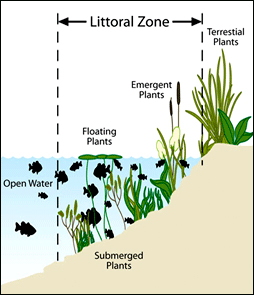
The lake shore (or littoral zone) is the shallow area along the shoreline of a lake or pond which supports diverse communities of rooted plants and serves as food, habitat and protective shelter for fish, insects, amphibians and other aquatic animals. These diverse plant communities also provide cover and nesting materials for a variety of wild birds and mammals. Management of littoral zones is often necessary in systems altered by humans.
Typical littoral zone problems associated with human activities include:
- Shoreline erosion
- Algal blooms due to input of excess nutrients
- Overgrowth of invasive exotic plants
- Removal of protective vegetation needed for fish habitat and cover
Weeds are critical to our eco system...
Aquatic plants are a natural part of most lake communities and provide many benefits to fish, wildlife, and people. In lakes, life depends--directly or indirectly--on plants. They are the primary producers in the aquatic food chain, converting the basic chemical nutrients in the water and soil into plant matter, which becomes food for all other life.
Aquatic plants serve many important functions:
Provide fish food
More food for fish is produced in areas of aquatic vegetation than in areas where there are no plants. Insect larvae, snails, and freshwater shrimp thrive in plant beds.
Sunfish--Minnesota's most sought-after game fish--eat aquatic plants in addition to aquatic insects and crustaceans.
Offer fish shelter
Plants provide shelter for young fish. Because bass, sunfish, and yellow perch usually nest in areas where vegetation is growing.
Improve water clarity and quality
Certain water plants, like bulrushes, can absorb and break down polluting chemicals. Nutrients used by aquatic plants for growth are not available to algae.
This reduces algae abundance improving water clarity. Aquatic plants also maintain water clarity by preventing the re-suspension of bottom sediments. Algae,
which thrive on dissolved nutrients, can become a nuisance when too many submerged water plants are destroyed.
Protect shorelines and lake bottoms
Aquatic plants, especially rushes and cattails, dampen the force of waves and help prevent shoreline erosion. Submerged aquatic plants also weaken wave action and help
stabilize bottom sediment.
Provide food and shelter for waterfowl
Many submerged plants produce seeds and tubers (roots), which are eaten by waterfowl. Bulrushes, sago pondweed, wild celery, and wild rice are especially important
duck foods. Submerged plants also provide habitat to many insect species and other invertebrates that are, in turn, important foods for brooding hens and
migrating waterfowl.
Improve aesthetics
The visual appeal of a lakeshore often includes aquatic plants, which are a natural, critical part of a lake community. Plants such as water lilies, arrowhead, and
pickerelweed have flowers or leaves that many people enjoy.
Provide economic value
As a natural component of lakes, aquatic plants support the economic value of all lake activities. Kentucky has a huge tourism industry centered on lakes and the recreation
they support.
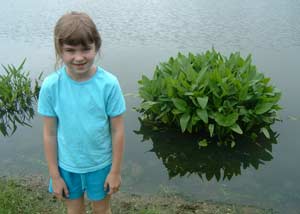
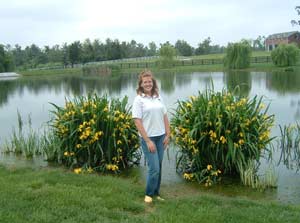
Pond edge plantings compete directly with the algae for nutrients. If selected properly, these plantings will add significant visual value to the body of water and surrounding area with their foliage and blooms. Many species are very low maintenance and come back year after year. Some may require occasional trimming and/or replacement. Most importantly, their root stock cleanse the water from the storm water runoff which is likely to contain harmful chemicals such as asbestos, copper, chromium, lead, nickel, phosphorous, zinc, oil, grease, herbicides and pesticides. The establishment of wetland vegetation improves water quality by recreating the natural wetland filtering mechanisms. Amoung the most important of these mechanisms is the ability to remove nitrogen and phosphorous. Another benefit of native vegetation is preventing bank erosion and capturing sediment. The thick root systems of native plants hold the soil on the banks and slopes above bodies of water, keeping sediment from clouding the detention basin.
Floating Islands
A Floating Island is essentially a balancing act that uses specially selected plants and a custom, proprietary mix of microbes to keep nutrients from building up. Because the plant roots on a floating island are in direct contact with the water, they are constantly extracting nutrients - so not only are they helping clean the water, they are also thriving in the process.
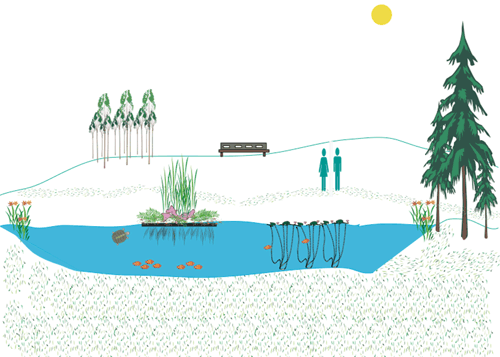
Improve water quality
Floating Islands are an effective tool in maintaining the health of ponds and lakes. The islands use a synergistic combination of plants and high surface area
substrate (matrix). In conjunction with our proprietary microbes and aeration, our islands can additionally help keep water clear and clean. These microbes work
synergistically with the matrix and roots of plants to remove excess nutrients from the water, greatly reducing algae growth, without harsh chemicals.
Enhance fish habitat
Fish benefit from improved water quality, and roots growing down into the water provide a food source for small fish - which in turn feed the big ones. Fish congregate
under the islands to take advantage of the shade and to escape avian predators like osprey, eagles, and herons.
Beautify and add interest to the waterscape
Lush with green growth and the colorful splash of flowers, the Floating Island is an enchanting addition to the waterscape. Islands can be fit with wind-generated aeration,
solar lighting, and other useful features.
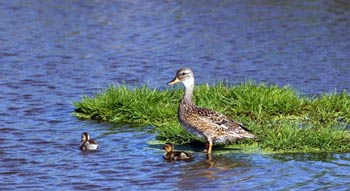
Provide wildlife habitat
Floating islands provide nesting and resting habitat for redhead ducks and loons, avocets and snipe, and a myriad of other bird species. Frogs deposit their eggs on
the plant roots, salamanders cruise the waterline, turtles haul out to bask, and glinting blue dragonflies dart and hover.








